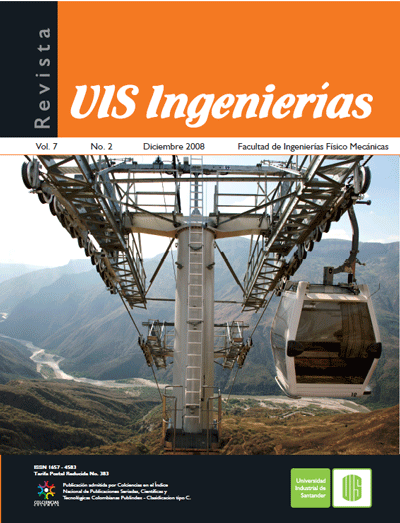Artículos
Estimación de la corriente de referencia de un filtro activo de potencia usando el filtro de kalman
Publicado 2008-11-05
Palabras clave
- calidad del suministro eléctrico,
- filtros activos de potencia,
- armónicos
Cómo citar
Petit-Suárez, J. F., Amarís-Duarte, H., & Robles-Muñoz, G. (2008). Estimación de la corriente de referencia de un filtro activo de potencia usando el filtro de kalman. Revista UIS Ingenierías, 7(2), 203–209. Recuperado a partir de https://revistas.uis.edu.co/index.php/revistauisingenierias/article/view/50
Resumen
En este artículo se presenta una nueva metodología que permite calcular en tiempo real la corriente de referencia de un filtro activo de potencia. La metodología está basada en el uso del filtro de Kalman como estimador de parámetros eléctricos y está enfocada para compensar los armónicos generados por cargas no lineales. La validez de la metodología es inicialmente demostrada mediante simulaciones en Matlab/Simulink y finalmente es comprobada al implementarla en un prototipo experimental de un filtro activo de potencia.
Descargas
Los datos de descargas todavía no están disponibles.
Referencias
IEEE std 519, “IEEE Recommended practices and Requirements for harmonic control in electrical power systems”. 1992.
H. Akagi, “Active harmonic flter”, Proceedings of the IEEE, vol. 93, no.12, pp. 2128-2141, Dec. 2005.
S. Bhattacharya, T.M Frank, D.M Divan and B. Banerjee, “Active flter system implementation”, IEEE Ind. Appl. Mag, pp.47-63, Sept/Oct. 1998.
H. Akagi, Y. Kanazawa and A. Nabae, “Instantaneous reactive power compensator comprising switching devices without energy storage components”, IEEE Transactions on Industry Applications, vol. IA-20, no. 30, pp. 625-630, 1984.
S. Fryze, “Wirk-. blind-. und scheinleistung in elektrischen stromkreisen mit nicht-sinusoidalen verlauf von strom und spannung”, journal ETZ, no. 25-27, 1932.
M. Depenbrock, “The FBD-method, a generally applicable tool for analyzing power relations”, IEEE Trans. Power Delivery, vol. 8, no. 2, pp. 381-387, May. 1993.
M. Sonnenschein and M. Weinhold, “Comparison of time-Domain and frequency-domain control schemes for shunt active flters”, journal ETEP, vol. 9, no. 1, pp. 5-16, Jan/Feb. 1999.
Y. Xiaojie and L. Yongdong, “A shunt active power flter using dead-beat current control”, Industrial Electronics Society IEEE 2002 28th Annual Conference-IECON 02, vol. 1, pp. 633-637, Nov. 2002.
S. Buso, L. Malesani and P. Mattavelli, “Comparison of current control techniques for active filter applications”, IEEE Transaction on industrial electronics, vol. 45, no. 5, pp. 722-729, October 1998.
M.P. Kazmierkowski and M.A. Dzieniakowski, “Review of current regulation techniques for three-phase PWM inverters”, 20th International Conference on Industrial Electronics, Control and Instrumentation, 1994. IECON ‘94, vol. 1, pp. 567-575, Sept. 1994.
J.F. Petit, H. Amarís and G. Robles, “Control schemes for shunt active flters to mitigate harmonics injected by inverted-fed motors”, Proc. 15th Power Systems Computation ConferencePSCC’05, Liège-Belgium, August 2005.
R.G. Brown and P.Y.C Hwang, “Introduction to random signals and applied Kalman fltering”, Ed. John Wiley & Sons, Second edition, 1992.
S.M. Bozic, “Digital and Kalman fltering: an introduction to discrete-time fltering and optimum linear estimation”, Ed. Edward Arnol, Second edition, 1994.
J.F. Petit. “Control de fltros activos de potencia para la mitigación de armónicos y mejora del factor de potencia en sistemas desequilibrados”. Tesis Doctoral. Universidad Carlos III de Madrid. 2007. España.
H. Akagi, “Active harmonic flter”, Proceedings of the IEEE, vol. 93, no.12, pp. 2128-2141, Dec. 2005.
S. Bhattacharya, T.M Frank, D.M Divan and B. Banerjee, “Active flter system implementation”, IEEE Ind. Appl. Mag, pp.47-63, Sept/Oct. 1998.
H. Akagi, Y. Kanazawa and A. Nabae, “Instantaneous reactive power compensator comprising switching devices without energy storage components”, IEEE Transactions on Industry Applications, vol. IA-20, no. 30, pp. 625-630, 1984.
S. Fryze, “Wirk-. blind-. und scheinleistung in elektrischen stromkreisen mit nicht-sinusoidalen verlauf von strom und spannung”, journal ETZ, no. 25-27, 1932.
M. Depenbrock, “The FBD-method, a generally applicable tool for analyzing power relations”, IEEE Trans. Power Delivery, vol. 8, no. 2, pp. 381-387, May. 1993.
M. Sonnenschein and M. Weinhold, “Comparison of time-Domain and frequency-domain control schemes for shunt active flters”, journal ETEP, vol. 9, no. 1, pp. 5-16, Jan/Feb. 1999.
Y. Xiaojie and L. Yongdong, “A shunt active power flter using dead-beat current control”, Industrial Electronics Society IEEE 2002 28th Annual Conference-IECON 02, vol. 1, pp. 633-637, Nov. 2002.
S. Buso, L. Malesani and P. Mattavelli, “Comparison of current control techniques for active filter applications”, IEEE Transaction on industrial electronics, vol. 45, no. 5, pp. 722-729, October 1998.
M.P. Kazmierkowski and M.A. Dzieniakowski, “Review of current regulation techniques for three-phase PWM inverters”, 20th International Conference on Industrial Electronics, Control and Instrumentation, 1994. IECON ‘94, vol. 1, pp. 567-575, Sept. 1994.
J.F. Petit, H. Amarís and G. Robles, “Control schemes for shunt active flters to mitigate harmonics injected by inverted-fed motors”, Proc. 15th Power Systems Computation ConferencePSCC’05, Liège-Belgium, August 2005.
R.G. Brown and P.Y.C Hwang, “Introduction to random signals and applied Kalman fltering”, Ed. John Wiley & Sons, Second edition, 1992.
S.M. Bozic, “Digital and Kalman fltering: an introduction to discrete-time fltering and optimum linear estimation”, Ed. Edward Arnol, Second edition, 1994.
J.F. Petit. “Control de fltros activos de potencia para la mitigación de armónicos y mejora del factor de potencia en sistemas desequilibrados”. Tesis Doctoral. Universidad Carlos III de Madrid. 2007. España.

